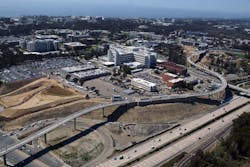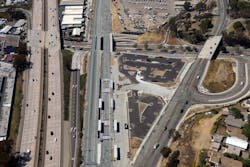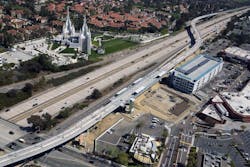Rail transit on the coast
For the last three decades, a half-cent sales tax dubbed “TransNet” has funded the completion of hundreds of transportation projects in San Diego County, the second largest county in the state of California.
One such project to benefit from the TransNet sales tax initiative is the Mid-Coast Trolley Project, led by the San Diego Association of Governments (SANDAG). This project will extend University of California (UC) San Diego Trolley service from the Santa Fe Depot in Downtown San Diego north to the University community. The project is an 11-mile extension with nine new stations starting at the Old Town Transit Center. The alignment roughly follows I-5 north to University Town Centre (UTC).
“This is essentially San Diego’s second downtown,” John Haggerty, Director of Engineering & Construction for SANDAG, told Traffic & Transit. “UTC is high-density—it has housing, commercial, office, and the university, and several major health centers.”
The line will operate at the UC San Diego Blue Line from the border with Mexico to UTC through the UC San Diego Campus. According to Haggerty, the $2.17 billion Mid-Coast Trolley project is the biggest project in terms of miles and cost that the San Diego Trolley system has ever seen and probably the biggest infrastructure project ever in San Diego.
The line will have three at-grade stations in an existing railroad corridor adjacent to commercial and residential properties. There will also be stations at two regional malls and an at-grade station at the VA Medical Center. Additionally, there will be two elevated stations on the UC San Diego Campus at the heart of the west campus and on the east campus adjacent to the UC San Diego Health System hospital and facilities—Preuss School and Scripps Hospital. There will also be one elevated station on Genesee Avenue in the middle of a financial and commercial center.
Clearing a congested corridor
The goal of the project is to provide high-capacity transit service in a highly congested corridor. According to SANDAG, freeways and arterials in the Mid-Coast corridor are generally congested, and traffic congestion is projected to increase as the region grows. By 2030, population in the corridor is forecast to increase by 19% and employment is expected to increase by 12%.
The idea is that the Mid-Coast Trolley project can provide an effective alternative to congested roadways for travelers, improve public transit services, and enhance travel options by connecting the corridor with areas served by the existing trolley system. In October 2017, SANDAG opened a regional transit center at UTC. The Mid-Coast Trolley project will directly connect to the transit center in order to increase transit ridership.
The project team includes WSP USA as prime consultant for design; Jacobs and PGH Wong as prime consultants for construction management; T.Y. Lin International as prime consultant for project management; and Mid-Coast Transit Constructors (a joint venture of Stacy and Witbeck, Skanska, and Herzog) as the prime contractor.
The project is approximately 90% complete. Final environmental clearance was granted to the project by the Federal Transit Administration (FTA) in 2014. Construction began in the fall of 2016, after the FTA signed a Full Funding Grant Agreement (FFGA) with SANDAG to provide the nearly 50% federal match needed to fund the project and allow construction to begin. The project is funded 52% through the TransNet local sales tax and 48% through the FFGA.
According to Haggerty, the Mid-Coast Trolley was a “lockbox project” that dates back to the original TransNet tax initiatives and has been in some form of development for 20 years. “But in the last 10 years preceding 2016, we were doing the alternatives analysis for alignment, the environmental analysis, and working on funding through the FTA,” Haggerty said. “These big projects take a decade or more to get to the point where you’re ready for construction.”
A third of TransNet revenue goes to transit improvements in San Diego County. With that sales tax revenue, SANDAG has completed several light-rail extensions. The Mid-Coast Trolley project is one of the highest priorities for SANDAG in its TransNet Early Action Program. Haggerty says this project is essentially the last of the TransNet trolley projects that goes north from Old Town to UTC.
Trolley bridges
The Mid-Coast Trolley project follows the I-5 corridor, which means it has to cross some waterways, roads, and other terrain. A handful of trolley bridges can be found along the project corridor, starting with one over the San Diego River, which leaves Old Town heading north crossing the San Diego River into and in an existing railroad corridor. Another bridge runs over Tecolote Creek. The team built another structure over Balboa Avenue, where crews also rebuilt the coastal bridges over what were called the LOSSAN corridor bridges. “We also have a pedestrian bridge associated with the trolley bridge, just because it’s a heavy boulevard and we needed access across that,” Haggerty explained. “Additionally, the project includes three smaller bridges over Rose Creek because the corridor meanders in and out of the alignment.”
Haggerty said the bridges that SANDAG usually builds are almost always cast in place. “But we have a flyover bridge where the trolley alignment just by nature is on the east side of the LOSSAN corridor,” he said. “We get farther north, the LOSSAN actually heads inland and goes around a big loop. So we actually have to get to the west side of that to continue north, and we built a precast flyover bridge—one of the first large precast bridges we had.”
The flyover bridge was a unique structure for the team to construct. The contractor had to build columns in between Rose Creek and the active LOSSAN corridor. “So we had to build this flyover bridge by building these large columns and then dropping in the beams. And that was a significant area in a very limited area to work,” Haggerty said. “Then we had two precast bridges over I-5. And I like our bridges, they have a nice haunch coming in so they’re not a flat bridge. So if you’re going along the freeway you’re going to pass under these two really well-shaped haunched bridges over I-5.”
The project also features an underpass below La Jolla Colony Drive, and a little over 4 miles of aerial guideway. “We cross I-8 once, across La Jolla Village Drive once—and La Jolla Village Drive is like 60 ft in the air—and then we go through the campus of UCSD on a bridge structure,” Haggerty explained. “We cross I-5 again because we turn back east, and then we go into the center of Genesee Avenue; it’s a six-lane boulevard, and so on the aerial structure all the way down Genesee Boulevard. And so what we call the viaduct after we come under La Jolla Colony, we’re essentially in the air for 4.3 miles. So there’s a long viaduct, which is mostly cast-in-place, but there’s about 1.7 miles of precast construction down Genesee.”
Haggerty said that the signature bridge is the Genesee section of the aerial guideway, which was designed as cast-in-place. The contractor proposed a precast option to reduce the amount of scaffolding and other construction impacts to this six-lane boulevard. The precast girders were delivered at night and erected at night, and then post-tensioned during regular shifts. The design uses two precast tub girders side by side with a top slab supporting the tracks.
The Mid-Coast Trolley project is expected to open in late 2021 to revenue service after undergoing a five-year construction sequence. Ultimately, the project is designed to improve access to growing employment, education, and residential areas and serves as a fine display of high-capacity transit supported by a vast network of rail bridges.


